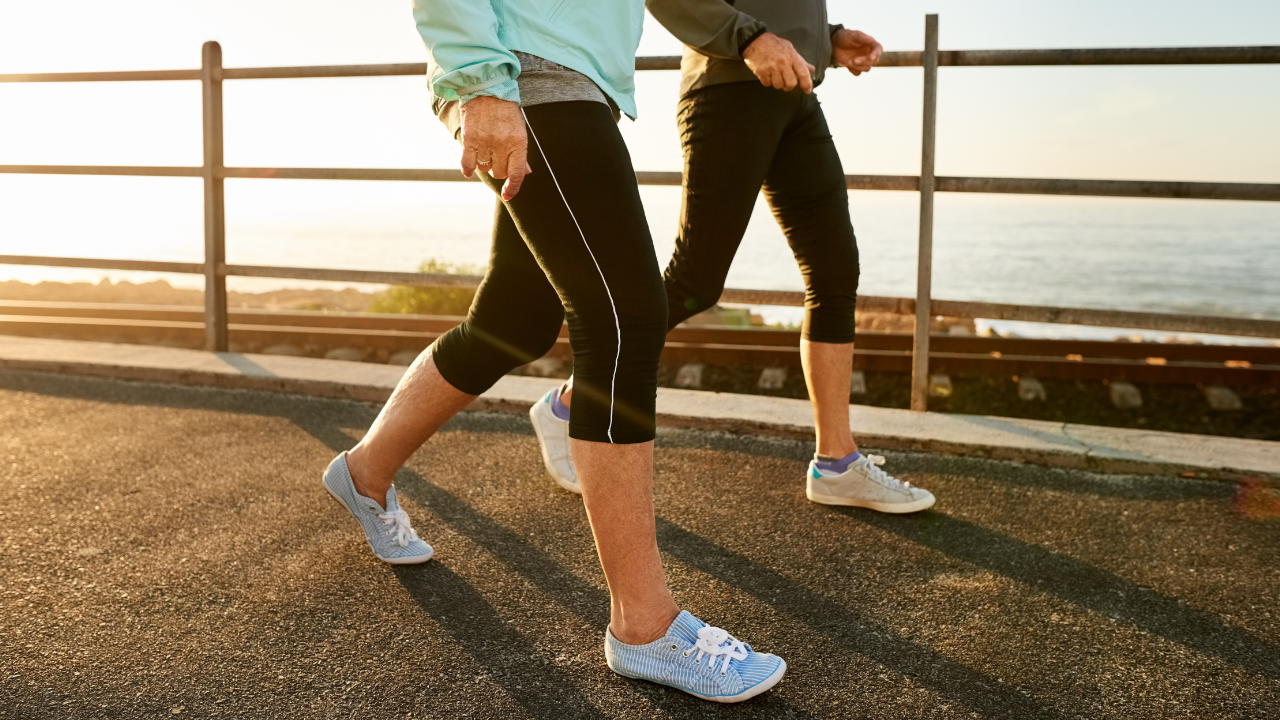Fitness
‘I Don’t Want To Be Old When I’m Old’—Defining Healthy Longevity

It takes some planning not to be “old” when you’re old.
getty
“I don’t want to be old when I’m old.” That sentiment was shared in a recent article in The New York Times by Elaine LaLanne, the 97-year-old widow of Jack LaLanne, who was one of the first TV celebrities to introduce personal fitness to millions of Americans.
So, what does it mean to be “old”? For many people, old is anyone 10 to 20 years older than their current age. The trouble is, it’s inevitable that you’ll age into the definitions of old that you considered to be true earlier in your life.
At age 70, I’ve blown through several definitions of old that I held earlier in my life. However, now I realize that I’m approaching the lifespan ceiling and can no longer put off ignoring the fact that some day, I will be old—at least chronologically. So, I’m looking carefully at how not to be “old” when I’m old.
Refine our personal fitness habits
As you might expect, Ms. LaLanne provides a good role model when it comes to personal fitness. She exercises every day for at least 20 minutes, doing jackknifes in her bed and incline pushups at the sink, walking on a treadmill, and building upper-body strength in the gym. She also practices good nutrition and maintains a healthy weight.
The importance of exercise, nutrition, and healthy weight to your fitness in retirement is well known. As you age, however, you’ll need to refine your exercise and nutrition habits.
For example, for many years, I exercised by swimming, biking, and practicing yoga. However, Ms. LaLanne’s focus on building her upper-body strength made me reflect on the fact that my parents became quite frail in their 80s and 90s; building upper-body strength could have helped them be more independent in their later years. So now, I’m regularly visiting the gym and lifting weights.
Eating more protein is another example of a refinement recommended by nutritionists for people in their 70s and older.
Expand our definition of “not being old”
Another frequent catch phrase you often hear is that “Age is an attitude.” Usually that means you should think like a young person. But what does that mean to a person who’s in their retirement years? For me, it means being curious, continuing to learn, and trying new things, no matter how old I am. However, I’ll also want to be discerning about these choices by applying my lifetime of experience: I don’t need to try things simply because they’re “shiny and new,” but I’ll be open to seeing if the new thing will really make my life better.
For example, I recently joined an outrigger canoe club, which has provided me with a new way to keep fit, build my upper body strength, and make new friends. I’m also investigating the idea of using Apple Pay, a mobile payment service that can replace a debit or credit card with built-in safety features. After rejecting it for years as some newfangled thing that only young people use, I think it’s time to look into it.
Another common definition of “old” is people who are no longer independent and need to rely on others for their daily care needs. What I’ve found, however, is that many people in their 80s and 90s commonly rely on others for social and logistical support. In reality, they’re “interdependent,” accepting help for various needs but also providing support to family, friends, and their community at large.
As a result, I’m looking for ways I can accept relying on others without compromising my sense of independence. One clear example is being ready to accept rides on public transportation or from family, friends, and Uber as my willingness and ability to drive diminishes in my later years.
Nurture our social fitness
Viewing retirement as a permanent vacation, when all you do is play, travel, and pursue hobbies, simply doesn’t work for retirements that can last 20 to 30 years. We need to be helpful and relevant to our communities, family, and friends no matter how old we are. That can mean continuing to work in some way, volunteering, or simply being there for family and friends when they need help. In our later years, our social fitness is just as important as our personal fitness.
Here’s an idea to consider: Ask close family and friends what age they think is old, and how not to be “old” when you’re old. You’ll start an insightful and provocative conversation.
Ms. LaLanne ended her interview with one more powerful insight: “You have to move. If you don’t move, you become immovable.”
Great inspiration and advice for not being old when we’re old!

Fitness
Crunch Fitness holds exercise fundraiser to support Augie's Quest…

Crunch Fitness will host a nationwide fundraising event to support Augie’s Quest to Cure ALS, an organization dedicated to funding innovative research, help develop treatments, and raise awareness of amyotrophic lateral sclerosis (ALS).
Both Crunch members and nonmembers may take part at Crunch locations nationwide on May 31, 9-10:30 a.m., local time. The event will feature a 90-minute Love Your Muscles class that will consist of three 20-minute training periods focusing on strength, core, and mobility, and a 30-minute dancing segment. The event costs $20, with all funds benefitting Augie’s Quest. Additional donations will also be accepted from people who don’t secure a spot in the class.
“At Crunch, we believe in making serious fitness fun, including engaging our community with awesome classes to support a larger cause,” Chad Waetzig, chief marketing officer of Crunch Fitness and Augie’s Quest fitness advisory council member, said in a press release. “We’re proud to have supported Augie’s Quest over the years through direct donations and by helping to raise awareness and funds for ALS research.”
Every 90 minutes
Augie’s Quest to Cure ALS was founded by Augie Nieto, a fitness pioneer who was diagnosed with ALS in 2005 and made it his the mission to find a cure for the progressive neurological disorder. Since its creation, the organization has raised more $200 million. Nieto died in 2023.
The event will include a segment on bodyweight strength, a Tough 20 class to focus on muscles of the core to improve posture, and an athletic class called Joint Ventures to improve mobility and flexibility. The program will finish with a special 30-minute Zumba or a So You Think You Can’t Dance party.
“This special 90-minute “Love Your Muscles” class goes beyond your average workout; it’s designed to challenge your body, celebrate movement, and bring the Crunch community together for a powerful cause,” the Love Your Muscles webpage states. “And there’s a deeper reason for the timing: every 90 minutes, someone is diagnosed with ALS, making each minute of this class a symbol of support, action, and hope.”
“We’re honored to be uniting the Crunch community across the country through powerful programming that not only celebrates the 20-year legacy of Augie’s Quest, but also energizes our members and fitness enthusiasts to move their bodies for meaningful change,” Waetzig said.
Fitness
10,000 steps a day or 30 minutes of Japanese walking? Harvard doctor explains which is better

Gastroenterologist Dr. Saurabh Sethi is in favour of the trending Japanese walking technique. “The Japanese have discovered a walking technique with more benefits than the traditional 10,000 steps. It is called interval walking, that is, alternating 3 minutes of slow walking with 3 minutes of brisk walking, like you are rushing to an important meeting. Do this for 30 minutes daily, and the results are impressive.”
He points out that, when compared to the 10,000 steps a day, the IWT can improve blood pressure, reduce stroke risk, improve mood, boost immunity and offer better sleep quality. “Studies show that this method can improve cardiovascular health and fitness significantly,” he points out.
“To start, walk at a comfortable pace for 3-5 minutes, then alternate slow and brisk walking. Finish with a 3-5 minute cool down. It is joint friendly, time efficient and very effective. Share this widely and follow for more,” the doctor suggests.
Fitness
Living with Chronic Fatigue Syndrome: Is it good to exercise?

Chronic Fatigue Syndrome makes you extremely tired and affects your sleep quality. So, can exercising help to manage the symptoms? Let’s find out on World Chronic Fatigue Syndrome Awareness Day.
Exercise is not just meant to manage a healthy weight, but also to reduce stress, as well as to keep bones and joints in top shape. Some moves may also be recommended to manage health conditions such as osteoporosis, diabetes and hypertension. But what if you feel too tired to do any kind of physical activity? Chronic Fatigue Syndrome is a condition that leads to extreme fatigue. Even after resting, you will feel too tired to do anything. It also has an impact on the quality of your sleep and your ability to concentrate. So, is exercising the solution? On the occasion of World Chronic Fatigue Syndrome Awareness Day on May 12, we tell you how exercising may help people with this long-term condition.
What is Chronic Fatigue Syndrome?
Chronic Fatigue Syndrome or Myalgic encephalomyelitis is a condition that can lead to extreme tiredness. It can affect anyone, including children. According to the UK’s National Health Service, this long-term condition can make you feel so tired that it can make daily activities like going to work or taking a shower difficult.
It can cause sleep problems, including insomnia. Sometimes, people with this condition sleep too much, and still feel like they have not slept properly. It can also lead to brain fog, and make it hard to think and concentrate properly. Due to disabling fatigue, which is unpredictable, it can disrupt personal, professional and social life of the person with this condition.
Can exercising help people with Chronic Fatigue Syndrome?
Physical activity may help to improve the Chronic Fatigue Syndrome symptoms along with muscle strength and cardiovascular endurance. But exercises should be done with supervision, according to The Royal Australian College of General Practitioners. Exercising with Chronic Fatigue Syndrome must be approached very carefully. “Gentle and well-paced physical activity can offer certain benefits if done correctly,” says physiotherapist Neha Gill.
Here are some of the benefits:
- Improves circulation: Gentle movement supports better blood and oxygen flow to tissues, which can help reduce brain fog.
- Prevents muscle deconditioning: Long periods of rest can lead to muscle weakness and joint stiffness. “Light activity helps maintain basic strength and mobility without overexertion,” says the expert.
- Supports better sleep: Calming movements like stretching, or even deep breathing may improve sleep quality, which is often poor in people with Chronic Fatigue Syndrome.
- Eases pain: Gentle stretching and mobility exercises can reduce muscle aches and stiffness.
- Boosts mood: Movement, even if it is light, can increase the production of endorphins and serotonin, the feel-good hormones. “Exercising can help manage anxiety and depression that often accompany chronic illness,” says the expert.
Exercises for Chronic Fatigue Syndrome
There are benefits of exercising, but it doesn’t mean you engage in high-intensity workouts or push through fatigue. Also, many people with Chronic Fatigue Syndrome are prone to dizziness, especially while standing, as per the US Centers for Disease Control and Prevention. So, exercises that involve standing, especially without any support, should be avoided. Instead, try these exercises for Chronic Fatigue Syndrome:
1. Diaphragmatic (Belly) breathing
- To try this technique, sit or lie comfortably.
- Place one hand on your chest, the other on your belly.
- Inhale through your nose so that your belly rises followed by ribcage.
- Exhale slowly through your mouth and feel your belly fall gradually.
- Repeat the steps for 5 to 10 breaths.
2. Seated marching
- Sit upright in a sturdy and comfortable chair with your feet flat.
- Lift your right knee a few inches, then lower.
- Alternate to your left knee.
- Do 10 to 15 repetitions slowly on each leg.
3. Seated shoulder rolls
- Sit tall with your arms relaxed.
- Roll your shoulders forward in small circles 5 times.
- Then roll them backward 5 times.
4. Wall push-ups
- You can try standing with support. Stand facing a wall, your arms stretched out and hands on the wall.
- Bend elbows to slowly bring your chest toward the wall.
- Push back to the starting position of wall push-ups.
- Do 5 to 10 reps, and rest as needed.
5. Ankle pumps
- Sit or lie down with your legs extended.
- Flex your toes toward you then point them away.
- Flex your ankle towards you then move it away.
- Repeat the steps 15 to 20 times slowly.
6. Cat-cow yoga pose
- Get on your hands and knees. You can use a cushion if you feel the need.
- Inhale then arch back and look up.
- Exhale, round your spine and tuck your chin.
- Repeat about 5 to 8 times.

7. Seated side bends
- Sit in a chair with your hands by your sides.
- Raise your right arm over your head and lean to the left.
- Hold for 5 to 10 seconds, return, and switch sides.
- Repeat 3 to 5 times per side.
Tips for exercising with Chronic Fatigue Syndrome
You need to be extremely careful while engaging in physical activity if you have Chronic Fatigue Syndrome. Here are a few tips:
- Start with just 1 to 2 exercises per session if needed.
- Rest between these exercises.
- No pain no gain doesn’t work, so never push through your pain or fatigue.
- Practice exercise in good posture, as doing any exercise correctly is far more important than repetitions.
- Use support props like pillows, chairs or walls.
- Understand your limits, and stay within your energy boundaries.
- Drink water before and after doing exercises for Chronic Fatigue Syndrome. “Also, eat a small, energy-supportive pre-workout snack like a banana if needed before light movement,” suggests Gill.
You need to be cautious while exercising with Chronic Fatigue Syndrome. The goal is to gently support your health without worsening the symptoms. High-impact exercises or strenuous workouts can trigger crashes in people with Chronic Fatigue Syndrome. So, choose gentle moves and breathing instead. Talk to a doctor or physiotherapist before working out.
Related FAQs
How to resolve chronic fatigue syndrome?
There is no cure for chronic fatigue syndrome. But lifestyle changes, medication, and cognitive behavioral therapy and physical therapy may help to manage the symptoms.
Can you live a normal life with chronic fatigue syndrome?
Mildly impaired people with chronic fatigue syndrome may be able to go to work. However, careful planning and management of activities are needed.
-

 Austin, TX3 days ago
Austin, TX3 days agoBest Austin Salads – 15 Food Places For Good Greens!
-

 Education1 week ago
Education1 week agoIn Alabama Commencement Speech, Trump Mixes In the Political
-

 Technology1 week ago
Technology1 week agoBe careful what you read about an Elden Ring movie
-

 Culture1 week ago
Culture1 week agoPulitzer Prizes 2025: A Guide to the Winning Books and Finalists
-

 Politics1 week ago
Politics1 week agoEPA chief Zeldin announces overhauls to bring agency back to Reagan-level staffing
-

 World5 days ago
World5 days agoThe Take: Can India and Pakistan avoid a fourth war over Kashmir?
-

 Education1 week ago
Education1 week agoUniversity of Michigan President, Santa Ono, Set to Lead University of Florida
-

 Technology5 days ago
Technology5 days agoNetflix is removing Black Mirror: Bandersnatch

















